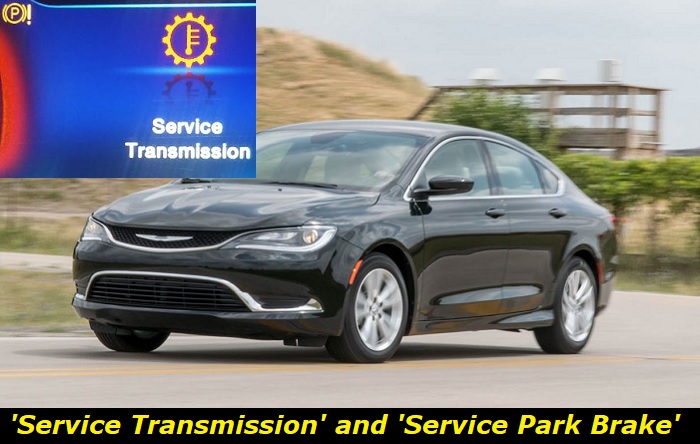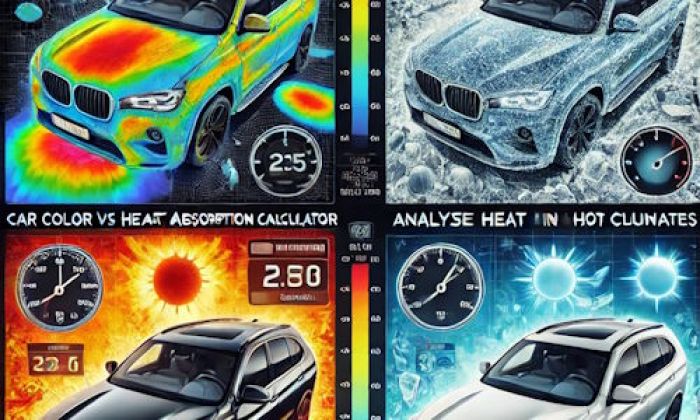The Chrysler 200 is no longer in production but it sure left an indelible mark in the market as it enjoyed high ratings in terms of reliability. There are, however, several flaws that the vehicle is known for. Among the known issues with it is its stalling or stuttering performance.
Service transmission and service parking brake messages highlights
- Common reasons:electrical problem, faulty sensors
- How to fix:read the codes with the scanner before any decisions
- Possible consequences:depend on the actual problem
- Priority level:Medium
- Can you drive?Carefully
- DIY repair:Possible
- Repair price range:$100-$500

Most Common Causes of the Chrysler 200 "Service Transmission" and "Service Parking Brake" Problems
Based on people familiar with the cause and solution to the problem, here are the most common culprits for this kind of issue:
1. Glitch in the TCM
Most of the time, the "Service Transmission" and "Service Parking Brake" problem is simply triggered by errors within the system of the Chrysler 200. In this case, you may get away from it the next time you restart your car and drive it for several miles. This can also be remedied by a hard reset through the disconnection of your car battery from its terminals.
In more serious cases, you may need to have the electronic control unit (ECU) of your vehicle reflashed to patch up its software with the latest recommended settings of its manufacturer to have it recalibrated and eliminate the errors within the TCM.
2. Corrosion in the TCM Connector
Corrosion in the TCM connector is a common cause for "Service Transmission" and "Service Parking Brake" issues in Chrysler 200 vehicles. This issue can be diagnosed most effectively by using a combination of visual inspection, manual testing, and diagnostic tools to identify the source of the problem.
In terms of visual inspection, corrosion around the TCM connector should be checked as this could indicate that moisture has infiltrated the electrical system. The wires connected to the connector should also be inspected for signs of wear or damage that may have been caused by a rodent or other forms of physical force.
Any abnormality noted during the inspection process should be documented so that it can be referenced during subsequent diagnostics steps.
To verify if the corrosion is causing an issue, manual testing should be conducted. This involves measuring the voltage at the TCM connector with a multimeter or other test equipment and comparing it to reference values provided by the vehicle's service manual. If there are any discrepancies between these two values, further troubleshooting will be required.
Diagnostic tools can also provide valuable insights into the source of the problem. A scan tool or specialized software for Chrysler 200 vehicles should be used to check for fault codes stored in the vehicle's computer system that could indicate a malfunction in the TCM. Additionally, visual readings from various sensors connected to the TCM can help determine if they are functioning properly and providing valid data.
If corrosion is found to be the source of the problem, the affected parts will need to be replaced to resolve it. This typically involves replacing the wiring, terminals, and connector housing associated with the TCM as well as any other components that may have been damaged by corrosion or mechanical force.
In some cases, complete replacement of certain circuits might be necessary. Once all components have been changed and tested for correct operation, the vehicle should resume normal functioning.
To prevent further issues related to corrosion in Chrysler 200 vehicles, regular maintenance should include an inspection of the TCM connector and its surrounding areas for signs of moisture infiltration or damage caused by external forces.
Additionally, performing electrical tests at least every six months can help identify any underlying problems before they become serious enough to cause service transmission and parking brake issues. By following these steps, future occurrences of corrosion-related issues in the TCM connector should be minimized.
3. Damage in the Wirings
Damage to the wiring harness in a Chrysler 200 can cause "Service Transmission" and "Service Parking Brake" issues due to an inability of the vehicle to send information back and forth between components. Usually, the problem is caused by damaged wires within the wiring harness, wrongly wired connections, or poor wire insulation that has caused shorts or other electrical malfunctions.
When diagnosing this issue, it is important for technicians to check for visual signs of damage such as broken wires or frayed insulation. They should also use tools such as multimeters or voltage testers to investigate any potential short circuits in the wiring harness.
To solve this, technicians will typically need to replace any affected parts in the wiring harness or other electrical components that have been damaged due to the wiring issue. They may need to re-route wires, change connectors and plugs, or solder new components onto existing wiring. All of these methods will help restore the connection between the transmission and parking brake for the Chrysler 200 to operate correctly.
By ensuring the wiring harness is properly maintained and regularly inspected by a technician, drivers can extend its lifespan and prevent further issues with their vehicle. In addition, maintaining electrical system components such as fuses, relays, sensors and other wiring accessories can also reduce the likelihood of problems occurring due to damaged wires within a harness.
Any repairs made to an electrical system must be done carefully with attention given to detail to ensure the reliable operation of the vehicle. With the correct tools, knowledge, and experience, technicians can quickly diagnose and repair any wiring harness issues that may be present. This will help to restore the electrical connection between the transmission and parking brake and return the Chrysler 200 to a reliable condition.
4. Sensor(s) Malfunction
The Chrysler 200 is known as one of the most reliable cars on the market, but transmission sensor malfunction can cause "Service Transmission" and "Service Parking Brake" issues. These problems arise when the sensors in question fail to operate properly, usually due to corrosion or wear and tear over time.
The symptoms associated with this issue include a transmission that is slow to engage or shifts erratically, as well as a parking brake that refuses to release when activated.
The best way to diagnose this problem is by paying attention to the symptoms listed above and conducting a visual inspection of the transmission components.
If any signs of corrosion or damage are visible then it may be necessary to use diagnostic tools such as an OBD2 scanner to detect any fault codes that may have been generated. If a fault code is present then it can provide further insight into the cause of the issue.
The remedy for this problem will typically involve replacing the faulty transmission sensor(s) as well as performing basic maintenance on the transmission system such as changing out worn-out components, cleaning off any corrosion, and inspecting all electrical connections. The cost of repairs depends on how extensive the work needs to be and whether or not additional parts need to be replaced.
Qualified technicians must handle these tasks to ensure safety and reliability within the vehicle's drivetrain system. Additionally, if any other parts are found to be damaged then those should also be replaced in order to avoid future problems.
With proper diagnosis and timely maintenance, the issue of transmission sensor malfunction should not cause major problems for the Chrysler 200. However, if these symptoms are ignored then it can lead to more serious issues down the line that will require a larger investment in repairs.
It is best to deal with this problem as soon as possible to avoid any further damage and save money on costly repairs. Taking preventative measures like regularly checking fluid levels and keeping up with scheduled maintenance appointments can help keep transmission-related issues at bay. Furthermore, a yearly inspection by an expert mechanic can be beneficial in preventing any future complications from arising. By taking these simple steps, owners of the Chrysler 200 can avoid costly breakdowns due to transmission sensor malfunction.
Making sure that the transmission sensors in a Chrysler 200 are functioning correctly is essential for the safe and reliable operation of the vehicle. Paying attention to symptoms, performing visual checks, using diagnostic tools, and replacing faulty parts will help ensure that this issue does not become a major problem. With timely maintenance, owners can avoid dealing with costly repairs down the road due to transmission sensor malfunction.
5. Faulty Transmission
Lastly, the "Service Transmission" and "Service Parking Brake" issues in the Chrysler 200 may be due to low transmission fluid levels, clogged or leaking filters, or even worn-out clutches. To assess the source of the problem, one should first look for any symptoms that may indicate a faulty transmission such as grinding noises when shifting gears and vibrations when driving.
Then, manually check the levels of transmission fluid and inspect the filter for any blockages or leaks. If these checks are inconclusive then professional diagnostic tools can be used to identify the cause of the issue with greater accuracy.
If it is found that there is indeed an issue with the parts of the transmission system, then the affected parts that may need a replacement include the transmission fluid, filter, and any worn-out components such as clutches or gears. The repair process can be complex so it is best to take the car to a certified mechanic for further assessment and repairs. However, by following proper maintenance schedules, issues like these can be avoided.
Conclusion
As shown here, the "Service Transmission" and "Service Parking Brake" issues can be a bit hard to diagnose in certain instances because they can range from electrical to mechanical problems in your Chrysler 200.
However, that does not mean they can't be repaired. By following the tips here and in the hands of an experienced mechanic or technician, you are likely to conveniently find a solution for the causes of the issues.
About the authors
The CarAraC research team is composed of seasoned auto mechanics and automotive industry professionals, including individuals with advanced degrees and certifications in their field. Our team members boast prestigious credentials, reflecting their extensive knowledge and skills. These qualifications include: IMI: Institute of the Motor Industry, ASE-Certified Master Automobile Technicians; Coventry University, Graduate of MA in Automotive Journalism; Politecnico di Torino, Italy, MS Automotive Engineering; Ss. Cyril and Methodius University in Skopje, Mechanical University in Skopje; TOC Automotive College; DHA Suffa University, Department of Mechanical Engineering






Add comment